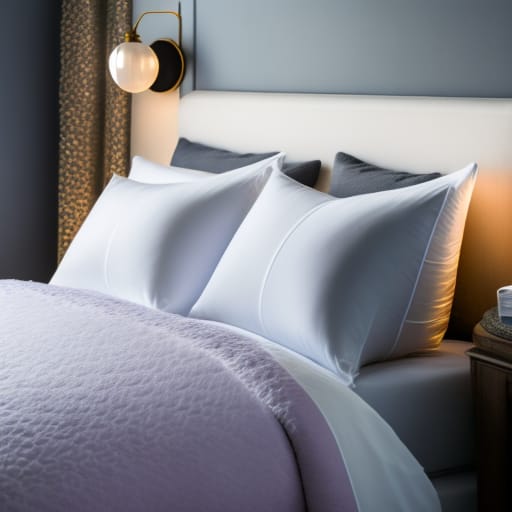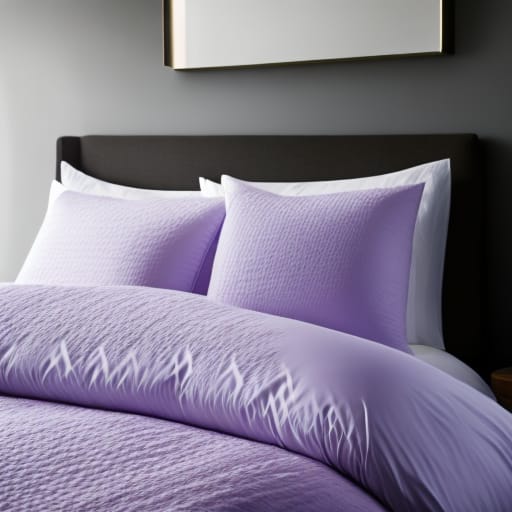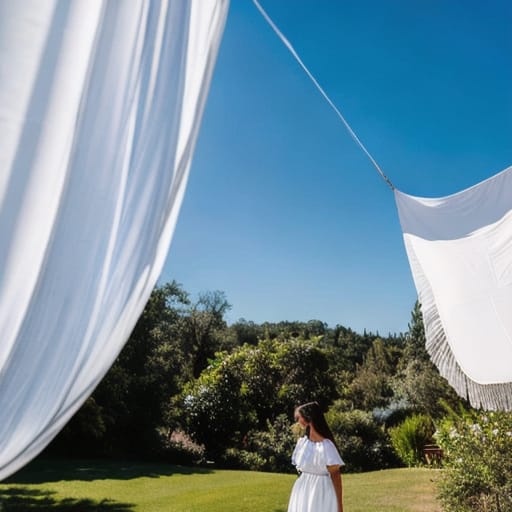Are you looking to add a fluffy, comforting, and warm down comforter to your bedding but don’t know where to start? This comprehensive beginner’s guide covers everything you need to know about down comforters from fill power, thread count, hypoallergenic properties, care and maintenance tips to ethical sourcing. Read on to understand the pros and cons to make an informed decision when purchasing your luxurious down comforter.
What is a Down Comforter?
A down comforter is a type of bedding filled with the fine, fluffy clusters and plumules that insulate birds and waterfowl. This superior fill comes from geese and ducks and is valued for its impressive warmth-to-weight ratio and comfort. Unlike regular comforters filled with less efficient materials like polyester and other synthetic fills, down offers unmatched lightweight warmth and breathability.
Down used for comforters is a byproduct of the food industry. Ethical down is gathered as a non-lethal harvest from mature birds during natural molting periods. Top brands follow responsible standards outlined by the American Down and Feather Council (ADFC) and RDS organizations for animal welfare and traceability.
A Brief History of Down Comforters
Down comforters trace back to the Middle Ages in Europe’s frigid alpine countries like Hungary and Poland. People insulated their beds with eiderdown, the fine under-plumage of the Eider duck.
Down fill interiors eventually got covered in a protective shell fabric or “ticking.” Continental Europeans called these kisteder or kistifedér, while the British dubbed them “comforters” for their unparalleled warmth and plush coziness.
Down comforters reached peak popularity in America throughout the early 20th century. Today innovative technologies like baffle-box construction propel down bedding towards new levels of luxury, comfort, and convenient care compared to traditional sewn-through styles.
The Importance of Fill Power
Fill power indicates the fluffiness, insulation value, and quality of down. It measures the cubic inches one ounce of down fills in a testing chamber and ranges from 400-900. This signifies how much air gets trapped between clusters, directly relating to warmth retention.
- Higher fill powers from 650-900+ provide the most lightweight efficiency and plush comfort.
- Mid-range options from 500-650 balance affordability with cozy insulation.
- Budget down comforters marked 400-500 work well for warmer climates or seasonal use.
Premium European white goose down ranks top-tier in resilience, fill power, and longevity compared to lower price point duck varieties. Investing more upfront costs less long-term as higher grades loft better season after season.
Types of Down Comforters
Goose Down vs. Duck Down
Both geese and ducks provide exceptional insulation as down comforter fill. However, the two types differ slightly:
Goose down offers superior:
- Durability – Longer-lasting with better resilience against compression
- Warmth – Higher loft and fill power trapping more heat
- Softness – Gentler with more soothing sink-in comfort
Duck down tends to have:
- Affordability – 20-50% lower cost than goose
- Breathability – Slightly more moisture wicking
With proper care, both produce ultra-comfy bedding. Goose down warrants the splurge for unparalleled longevity, insulation, and luxurious comfort.
Down Alternative Comforters
For budget buys or ethical concerns over animal products, down alternative comforters offer synthetic fills. Materials like microfiber polyester or brushed cotton mimic qualities of natural down clusters.
Pros:
- Cost – Far more affordable than genuine down
- Allergies – Hypoallergenic with no animal proteins
- Easy care – Can throw in washer and dryer
Cons:
- Durability – Fibers break down faster than down clusters
- Warmth – Less efficient insulation needing more fill
While improving, even high-end down alternatives cannot fully replicate the unbeatable cozy lightness of premium goose down comforters.
Sustainable and Ethical Down
Reputable brands ethically source RDS-certified down comforters safeguarding duck and goose welfare. Suppliers follow the American Down and Feather Council (ADFC) farm assurance standard covering:
✔️Animal welfare in humane handling
✔️Traceability via supply chain audits
✔️Proper nutrition and access to open water
✔️No live-plucking or force-feeding
Conscientious brands like Cuddledown also ensure responsible labor rights to produce Oeko-Tex Standard 100 certified down bedding. This indicates harmful substances stay far away from your cozy comforter.
How to Choose the Best Down Comforter
While all down comforters promote heavenly rest under plush covers, certain factors determine ideal options custom-fit for your sleeping needs and environment. Consider these elements when selecting a down-filled bedding upgrade:
1. Warmth Level Based on Fill Power
Matching warmth ratings to your climate prevents sweating or chilliness. Most quality down comforters list both fill power from 400-900+ and season ratings:
If you run hot or cold, adjustable dual-sided designs allow customizing insulation levels. Other high-tech models even self-regulate temperatures using special smart down clusters.
2. Shell Fabric Thread Count and Materials
Down proof shell fabrics prevent leaking feathers. High thread counts over 300 feel pleasantly smooth and sturdy. Luxury sateen cotton shells with 500+ threads count promote cozy breathability.
For allergy resistance, look for tightly woven 100% cotton, organic percale cotton, eucalyptus, bamboo or microfiber shells. Certain fabrics also receive antimicrobial treatments helping combat dust mites.
3. Hypoallergenic Properties
To prevent allergies look for:
- 👃 Hypoallergenic goose down processed to remove over 75% of prickly proteins and debris associated with reactions
- 🌿Oeko-Tex certified materials thoroughly analyzed as chemical and irritant free
Further allergy guards come from:
- 🧼Sanitized® anti-microbials applied to inhibit bacteria, mold and fungi over 8 years
- 🛏️Dust mite resistant tightly woven 230+ thread count cotton or microfiber shells
For those highly sensitive, woven eucalyptus or bamboo derivatives soothe better than cotton bedding shells.
Down Comforter Construction
From outer fabric shell to inner fill regulation, high-quality construction optimizes down comforters for even distribution, maximum loft and convenient care.
Baffle Box vs. Sewn-Through Designs
Baffle box construction sews fabric walls between an exterior and interior shell to create square compartments housing down. This prevents shifting for consistent comfort. More baffles provide cradling support all night.
Sewn-through comforters get completely stitched from edge to edge allowing fill to clump. These breathe well in summer but uneven cold spots can develop. Still, all-season 400-600 fill power sewn-through down comforters offer quality on a budget.
Downproof Shell Fabrics
To avoid poking feathers, woven 100% cotton or microfiber shells catch errant quills. With sewn-through styles focusing only on the exterior fabric’s weave, baffle boxes use double weave shells inside and out.
Tightly woven fabrics with a higher thread count feel extra luxurious. Lightweight, breathable sheets of 100% Egyptian or Pima cotton with 400-500+ thread counts promote healthy rest, especially for allergy sufferers.
Pair with a Duvet Cover
A removable duvet cover protects down comforters from body oils and spills while laundering less often. Like pillowcases for bedding, soft cotton or microfiber duvet covers safeguard your investment in plush comfort.
Caring for a Down Comforter
With the right maintenance, a quality down comforter lasts over 10 years. Here’s how to care for down bedding:
Washing Guidelines
- 💧Spot clean stains quickly using a damp cloth with mild detergent
- 🚰Rinse out in cool water if needed then air dry completely
- 🧺 Machine wash 2-3 times a year using a large commercial washer without agitator
- ❌Avoid hot water above 105°F as heat damages down
- 🧴Use mild detergent without bleach or fabric softeners
- 🚫Never wring or high heat dry to prevent clumping
Safe Storage
- 🏠 Store cleaned, completely dried down comforters in breathable king-size pillowcases
- 🧺 Use lightweight quilt storage bags allowing airflow to prevent mildew
- 🚫 Avoid excess compression crushing loft
Revitalizing Down
- 🪶 Fluff before use and occasionally reshape
- ☀️ Air out in sunlight to restore loft
- 🧽 Dry clean instead of washing when heavily soiled
- 🧵 Repair small tears to avoid leakage
Recondition treatments can revitalize flattened down and fade stains over time.

Choosing Down Comforters by Season
The optimal insulation level varies by climate and personal preference. Here’s how to select the best down-filled bedding for year-round comfort:
Lightweight Summer Down Comforters
Hot sleepers and humid southern locales benefit from ultralight down comforters with lower fill power around 400-500. These breathable options keep you cool enough for summer AC-free comfort.
Pros:
- 🍃 Excellent airflow and moisture wicking
- ❄️ Still warm enough for chilly summer nights
Cons:
- 🥶 Lack insulation for most winter use
Light, gauzy shells like 300-500 thread count sateen cotton or linen optimize temperature regulation.
All-Season Down Comforters
The most popular middle ground, mid-weight down comforters with 550-600 fill suit year-round use in most climates. Their balanced insulation keeps you cozy sans sweating or shivering.
Most reputable brands like Cuddledown sell this versatility. Make sure to pick medium warmth levels ideal for spring, fall and compatible with AC’d rooms.
Pros:
- 🧣 Versatile 3-season usage in varying temps
- 💵 Good value for year-round investment
Cons:
- 🥵 May overheat peak summer
- ❄️ Won’t be warm enough for harsh winters
Those in moderate New England or Pacific Northwest climates benefit most from this optimal balance of insulation.
Ultra-Warm Winter Down Comforters
Where frigid temps, snow or negative Fahrenheit readings hit regularly, arctic explorers and Minnesotans need abundant insulation from extra-plush winter down comforters.
Ideal for log cabin mountain getaways, these heavyweights insulate up to -30°F with their 650-900+ fill power. Pair with pre-warmed flannel sheets for ultimate hibernation.
Just take care not to overheat using high fill winter down comforters in warmer rooms or lower altitudes.
Pros:
- 🥶 Filters freezing air for polar climes
- 🛌 Warms beds quicker than other bedding
Cons:
- 🥵 Too hot for moderate and southern zones
- 💸 Pricier than lighter versions
Why Choose Down Comforters?
Beyond cozy warmth, premium down-filled bedding offers exceptional:
1. Luxury Comfort
Fluffy down surrounds you like a puffy cloud for heavenly cushioning that cradles joints without sagging. Natural clusters feel gentle, evenly dispersing weight relief across the covers.
2. Temperature Regulation
Down comforters insulate without trapping humidity or heat. Breathable constructs allow body moisture to pass through preventing sticky sweating. Adjustable fill levels suit both cool and warm sleepers.
3. Longevity
With proper care, high fill power goose down comforters last over a decade. Down resists deterioration and clumping better than alternative fibers and cheap, low-grade duck feathers.
Time and use just make premium European white goose down even softer. This explains why quality hand-me-down down comforters get passed down generations.
Buying Guide for Allergy Sufferers
Those susceptible to allergies and asthma benefit greatly from hypoallergenic down comforters. Here’s how to shop for down bedding avoiding irritants:
1. Seek Out Ultra-Clean Down
Hypoallergenic down undergoes extra purifying washes to strip away over 75% of antigens causing allergic reactions. This leaves only the FIRA-compliant fluffy fill behind.
Reputable brands sell comforters clearly labeled “hypoallergenic” meaning they are: 👃 Allergen-free 🧫 Independently lab tested
2. Prioritize High Thread Count Cotton Shells
Bedding covers woven more densely prevent dust mites, pet dander, mold and mildew from entering. 100% cotton with 400+ thread counts optimizes protection while promoting healthy airflow.
3. Look for Anti-Microbial Shields
Silver ion, lavender essence and other antimicrobial coatings prevent microbes like bacteria and fungi from growing in down bedding. This deters mustiness and other allergy triggers over time.
Sanitized®, Ultra-Fresh® and lavender-infused products guard against microbes, mold and mildew for years.
Top-Ranked Down Comforter Brands
Industry leaders renowned for ethical sourcing, quality construction and customer service earn recognition from testing authorities like Wirecutter and the New York Times:
Cuddledown’s Signature Down Comforters
Specializing in down bedding for over 40 years, Cuddledown earns awards as the New York Times’ #1 rated down comforter brand in 2022. Sourced sustainably from mature geese during natural molting periods, Cuddledown’s signature baffle boxes come in all-season and winter-weight versions.
Wirecutter’s Budget Pick: Eddie Bauer Friendly Down Comforter
This 550 fill power goose down comforter balances quality and value earning Wirecutter’s “best budget pick” two years running. While not as lofty as luxury brands, comfort stays consistent thanks to adequate 700 fill power duck down layered on top of 750 fill power goose down.

Responsible and Sustainable Down Production
Conscientious companies uphold safe, humane standards for sourcing, handling and crafting fine bedding. Here’s what to look for when ethical production matters:
1. Seek Out Certified Responsible Down Standards (RDS)
The Responsible Down Standard audits waterfowl welfare across the entire supply chain. Brands certified hold suppliers accountable for: ❌ No live-plucking or force-feeding 🍗 Ethical food and housing
🐥 Third-party verification of humane practice
2. Support Eco-Conscious Companies
Top bedding brands like Cuddledown strive for local New England-based manufacturing supporting domestic jobs. They also pioneer protective gear and housing for safe, socially distanced operations.
Such conscientious organizations partner with North American suppliers like United Feather & Down for traceable, RDS-approved materials. Farms there uphold the Five Freedoms of Animal Welfare while giving back 1% to wetland conservation.
Frequently Asked Questions
1. How often should you replace a down comforter?
With proper care like seasonal washings and dry cleanings, quality down comforters last over a decade before losing resilience. Higher fill power goose down around 700-900 holds up even longer than lower grade duck varieties thanks to unmatched durability.
Replace budget down comforters under 400 fill power every 2-5 years as clumping becomes an issue. Investing in finely crafted bedding from reputable brands like Cuddledown saves money in the long run.
2. Is it better to have a higher thread count for down comforter shell?
Yes, shell fabrics with higher thread counts over 400 feel ultra-smooth, prove more durable, and prevent fill leakage better. Egyptian cotton woven to 400-500+ thread counts optimizes both cozy softness and strength.
Cuddledown’s sateen cotton shell with a 500 thread count stands up better over time while promoting airflow. Percale cotton over 400 threads offers a crisp alternative.
3. What is the benefit of baffle box construction?
Baffle boxes keep insulating down fill evenly distributed and lifted for consistent comfort. This prevents cold spots from shifting clusters like what happens after years of use with sewn-through comforters. Supportive baffling also provides a cradling sensation preferred for the luxurious hotel bed feel.
4. Does a higher fill power guarantee a warmer down comforter?
No, fill power alone doesn’t perfectly predict insulation value. But when combined with the right shell fabrics and construction style for your sleeping needs, it comes extremely close.
That’s why matching warmth ratings and fill power numbers to your climate and seasonality helps select the ideal down comforter.
5. How much does a quality down comforter cost?
Pricing varies based on fill power, size, shell materials and construction quality but expect to invest for cozy durability. Here are typical price ranges:
- 💰 Budget: $100-$250 for 400-550 fill
- 💰💰 Mid-Range: $250-$500 for 550-650 fill
- 💰💰💰 Premium: $500+ for 700+ fill power








